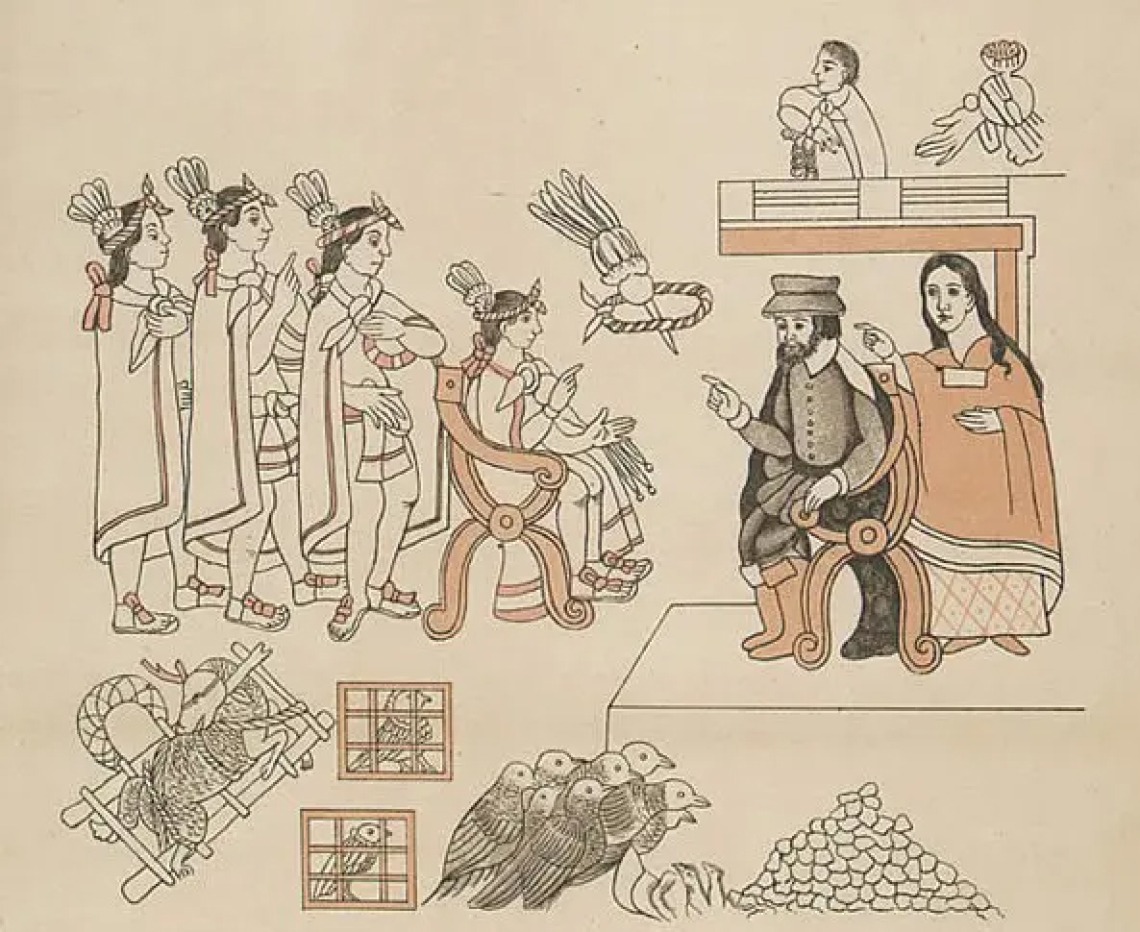A five-part series taught by Dr. Michael M. Brescia, Curator of Ethnohistory and Professor of History

Facsimile (c.1890), The Lienzo de Tlaxcala, “Hernán Cortés and Malintzin meet Moctezuma in Tenochtitlan, 1519.”
When
Wednesdays: October 23, 30 and November 6, 13, and 20, 2024
9:30-11:30 AM (with a break at the halfway point)
In person in ASM Room 309 (limited space) or on Zoom
Biography remains a favorite genre of nonfiction for bibliophiles and the general public alike. Compelling life stories transport readers to strange and familiar places, introduce historical context, and have the ability to promote empathy and a deeper understanding of seemingly disparate lived experiences. Early Mexican history is no exception, of course, as it provides us with a series of interconnected lives and cultural experiences filtered through the disparities of power that accompanied Spanish colonialism and its multiple agents: conquistadors, Catholic priests and nuns, royal administrators, and Indigenous nobles and commoners.
Session 1: Biography as History and the Origins of Mestizaje in Mexico
Dr. Brescia introduces the major themes of the Master Class and establishes the nature and scope of biography as a tool to uncover the historical experiences of Indigenous peoples and Spaniards in the early days of cross-cultural contact and exchange, followed by the violence of conquest, demographic collapse of Native communities due to Old World diseases, and the biological and cultural blending of myriad peoples. As an exemplar, we will examine the lives of Malintzin—often called La Malinche in history textbooks—and Hernán Cortés, and how their relationship evinced the complexities of Mesoamerica and early modern Spain.
Session 2: Early Colonial Elites, the Common Man, and the Push for Evangelization
In the second session of our Master Class, Dr. Brescia will explore the establishment of the colonial Mexican Church via Juan de Zumárraga, the first bishop of Mexico City and so-called defender of the Indians, who had to broker competing political and economic interests among the Spanish population while promoting the spread of Christianity among the Indigenous peoples. Former Aztec nobles, such as Don Carlos de Texcoco, and Aztec commoners, such as Juan Diego, go beyond the role of foil and show us the many ways in which Spanish colonialism simultaneously transformed Indigenous society and was transformed by it. Spanish Christianity would become Indian Christianity in Mexico.
Session 3: The Long Seventeenth Century, Part I: Bishop-Viceroys and Collective Biography
In the third session, Dr. Brescia will assess the political and social conflicts that erupted in Mexico during the early seventeenth century, as the Habsburg monarchy navigated multiple challenges to its power, including a shifting geopolitical landscape, competing corporate interests within the Mexican Church, and declining economic fortunes that eroded Spain’s standing among European powers. Juan de Palafox y Mendoza arrived in 1640 wielding both secular power as visitor-general (and eventually interim viceroy) and ecclesiastical power as bishop of Puebla, and he soon clashed with various religious corporate entities such as the Mendicant orders, especially the Franciscans, and the Society of Jesus (Jesuits). His nine-year tenure reveals the inherent tensions between an individual’s exercise of power and the collective interests that evade or stymy those efforts. The maturation of Spanish rule in North America was messy and full of discord and yet it unfolded amid the cultural fluorescence of the Baroque.
Session 4: The Long Seventeenth Century, Part II: “Foolish Men” and the Tenth Muse
Sor Juana Inés de la Cruz fashioned the intellectual, literary, and cultural edifice of the Mexican Baroque through her prodigious works of poetry, prose, and plays. As a woman who rejected the strictures imposed on women by Spanish colonial society, Juana entered the convent and became a nun, in part to cultivate her intellectual pursuits. Not surprisingly, she clashed with the hierarchy of her religious order and that of the Mexican Church, especially the bishop of Puebla, Manuel Fernández de Santa Cruz, who at first tried to dampen her scholarly and creative activities but soon decided to prohibit Sor Juana Inés from pursuing any such endeavors. Her biography allows us not only to explore the social domains assigned to elite women in Mexico (viceregal court, marriage, conventual life) but also confront the gendered dynamics of power that sought to control women’s movements, as well as the limits of Sor Juana’s pushback.
Session 5: The Enlightenment Comes to Mexico: Late Colonial Stress and Independence
The intellectual wave that swept through Europe in the eighteenth and nineteenth centuries also reached the shores of North America. Heralding radical ideas such as individual liberty, democracy, and collective action in the form of revolution, the Enlightenment promoted reason and the scientific method at the expense of religious understandings of the world and the old scholastic frameworks that informed those understandings. When a crippling drought in Mexico converged with the Napoleonic invasions of Europe, parish priest Miguel Hidalgo y Costilla championed the cause of Mexican independence with his friends and allies, including Doña Josefa Ortíz de Domínguez, wife of the local city magistrate. Together, they sought to topple colonial social hierarchies, promote economic modernization, and remove Mexico from Spain’s colonial shadow. As this fifth and final session of our Master Class will show, despite the ultimate success of Mexican independence in 1821, many features of Spanish colonialism endured in North America.
$200 in person (includes campus parking, coffee and light snacks)
$150 on Zoom
Registration opening soon, but contact us to express your interest now





